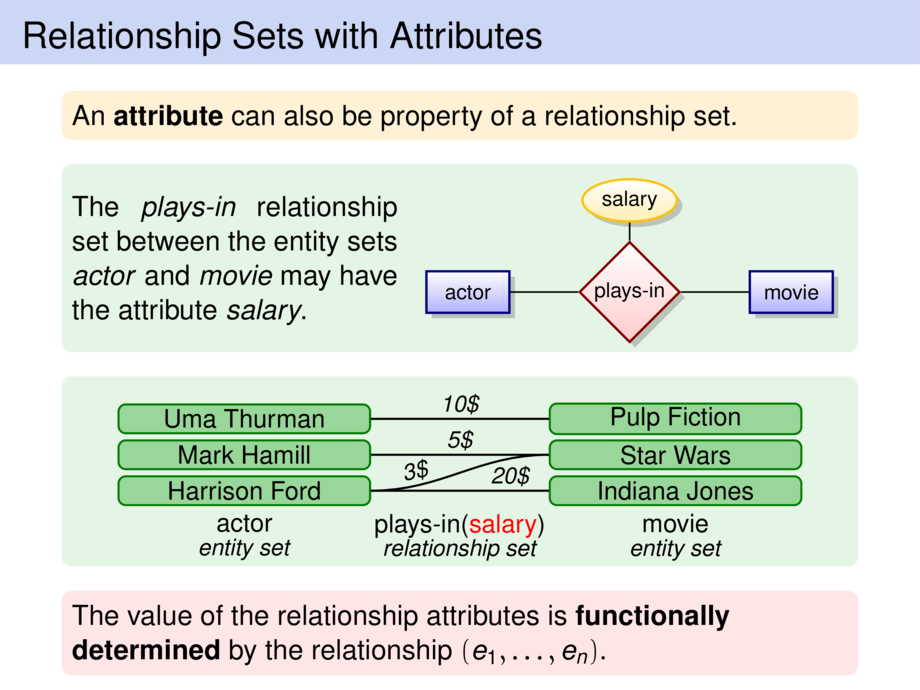



































































































49/98
\begin{frame}
\frametitle{Relationship Sets with Attributes}
\begin{goal}{}
An \emph{attribute} can also be property of a relationship set.
\end{goal}
\begin{exampleblock}{}
\begin{minipage}{.42\textwidth}
The \textit{plays-in} relationship set between the
entity~sets \textit{actor} and \textit{movie} may have the attribute \textit{salary}.
\end{minipage}
\begin{minipage}{.57\textwidth}
\begin{center}
\scalebox{.75}{
\begin{tikzpicture}[every edge/.style={link}]
\node[entity] (actor) {actor};
\node[entity,right of=actor, node distance=6cm] (movie) {movie};
\node[relationship] (plays) at ($(actor)!.5!(movie)$) {plays-in} edge (actor) edge (movie);
\node[attribute] (id) [above of=plays,node distance=1.7cm] {salary} edge (plays);
\end{tikzpicture}}
\end{center}
\end{minipage}
\end{exampleblock}
\pause
\begin{exampleblock}{}
\begin{center}
{\small
\begin{tikzpicture}[default,node distance=5mm]
\begin{scope}[nodes={rectangle, draw=cgreen!80!black, minimum width=35mm, minimum height=4mm, rounded corners=1mm, fill=cgreen!40}]
\node (a1) {Uma Thurman};
\node (a2) [below of=a1] {Mark Hamill};
\node (a3) [below of=a2] {Harrison Ford};
\node (s1) [right of=a1,node distance=60mm] {Pulp Fiction};
\node (s2) [below of=s1] {Star Wars};
\node (s3) [below of=s2] {Indiana Jones};
\end{scope}
\begin{scope}[node distance=7mm]
\node (l) [below of=a3,align=center] {actor\\[-.5ex] \remark{entity set}};
\node (r) [below of=s3,align=center] {movie\\[-.5ex] \remark{entity set}};
\node at ($(l)!.5!(r)$) [align=center] {plays-in(\alert{salary})\\[-.5ex]\remark{relationship set}};
\end{scope}
\draw (a1) to[out=0,in=180] node [sloped,above] {\remark{10\$}} (s1);
\draw (a2) to[out=0,in=180] node [sloped,above] {\remark{5\$}} (s2);
\draw (a3) to[out=0,in=180] node [sloped,above,pos=.25] {\remark{3\$}} (s2);
\draw (a3) to[out=0,in=180] node [sloped,above,pos=.8] {\remark{20\$}} (s3);
\end{tikzpicture}}\vspace{-1ex}
\end{center}
\end{exampleblock}
\pause
\begin{alertblock}{}
The value of the relationship attributes is \emph{functionally determined}
by the relationship $(e_1,\ldots,e_n)$.
\end{alertblock}
\end{frame}

